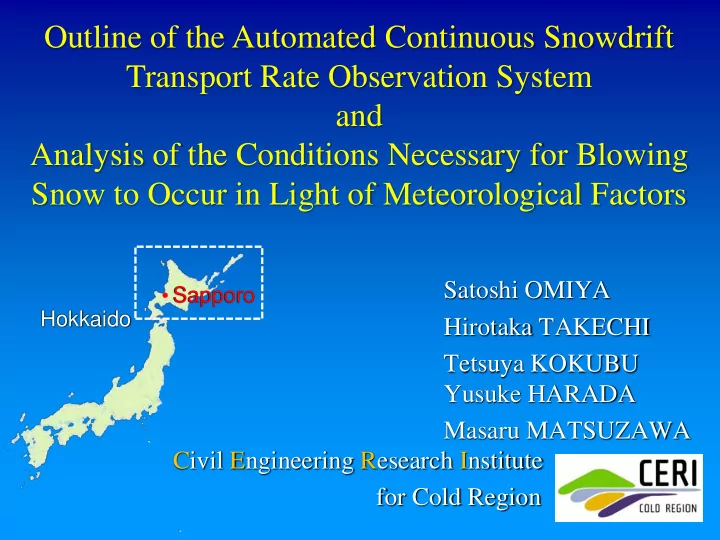

Outline of the Automated Continuous Snowdrift Transport Rate Observation System and Analysis of the Conditions Necessary for Blowing Snow to Occur in Light of Meteorological Factors Satoshi OMIYA ● Sapporo Hokkaido Hirotaka TAKECHI Tetsuya KOKUBU Yusuke HARADA Masaru MATSUZAWA Civil Engineering Research Institute for Cold Region
Introduction “Snowdrift Transport Rate” is important quantity for blowing snow countermeasure
About the Snowdrift Transport Rate “Snowdrift transport rate” is Mass ~ ~ ~ ~ of snow particles that passes a unit * * width perpendicular to the wind * * * direction per unit time. * 1m but .... Direct and continuous measurements are difficult In general, we use empirical equations to estimate “Snowdrift transport rate” ・ Log Q = 1.18+0.089 U ・・・ Budd et al. (1966) ・ Q = 0.03 U^3 ・・・ Kobayashi (1969) ・ Q = 0.2 U^2.7 ・・・ Takeuchi (1979) …old snow ・ Q = 0.029 U^4.16 ・・・ Takeuchi (1979) …compacted snow ・ Q = 0.005 U^4 ・・・ Matsuzawa et al. (2010) etc…
Comparison results of empirical equations There are quantity gaps One reason is an influence of the complicated blowing snow occurrence conditions
Topics of this presentation 1. Outline of the “Automated Continuous Snowdrift Transport Rate Observation System” 2. Analysis results of the Occurrence conditions of blowing snow (without concurrent falling snow)
Installation point of the observation system Wind Ishikari Blowing-Snow Hokkaido Test Field (Experimental facility of CERI) ★ Ishikari ★ ( N43 ° 12’, E141 ° 23’ ) ★ Sapporo
Appearance of Automated Continuous Snowdrift Transport Rate Observation System Four observation towers Monitoring and collection of the observation data can be accessed remotely online .
Details of observation tower Snow Particle Counter (SPC) Sampling area Supersonic type anemometer Classify 64 class (50 – 500 μm ) Install height ・ 3m, 7m (fixed height) ・ 0.1m - 2m (movable height)
Monitor screen on the web Instantaneous data of the wind velocity and direction
Monitor screen on the web Day-data of the mass flux and wind velocity
Monitor screen on the web Day-data of the mass flux and wind velocity
Monitor screen on the web Day-data of the mass flux and wind velocity
Monitor screen on the web Size distribution of blowing snow particle
Topics of this presentation 1. Outline of the “Automated Continuous Snowdrift Transport Rate Observation System” 2. Analysis results of the Occurrence conditions of blowing snow (without concurrent falling snow)
Previous study Takeuchi (1986)
Observation site Observation items ・ Air temperature ・ Wind velocity ・ Wind direction ・ Snow depth ・ Intensity of solar radiation ・ Visibility ・ Mass flux of blowing snow particles
Analysis Total number of events Occurrence: 1449 cases Non-occurrence: 8001 cases
Analysis Discriminate analysis T : Air temperature t : Elapsed time from the snowfall end Tmax : Maximum air temperature after the snowfall end Umax : Maximum wind velocity after the snowfall end Usum : Fourth power of the calculation of wind velocity from the snowfall end Sol : Integration of solar radiation amount from the snowfall end SF : Snowfall depth just before blowing snow has occurred ⊿ SD : Snowfall amount just before blowing snow has occurred In the case of t <12: N = - 0.5 9U + 0.2 T - 0.0 8SF + 4.77 In the case of t ≧ 12: N = - 1.18 U + 0.16 T + 0.09 t + 0.03 Usum + 4.93
Accuracy of the formulae Hit ratio = 91.1% The accuracy verification test showed the formulae to be useful in determining the occurrence of blowing snow
Summary 1. "Automated Continuous Snowdrift Transport Rate Observation System” ・ System has four observation towers and each tower has supersonic type anemometers and Snow Particle Counters ・ Monitoring and collection of the observation data can be accessed remotely online
Summary 2. Occurrence conditions of blowing snow ・ Using multiple meteorological elements, we made formulae to discriminate the occurrence of the blowing snow ・ As a result of an accuracy verification test, the results was 91.1%.
Recommend
More recommend